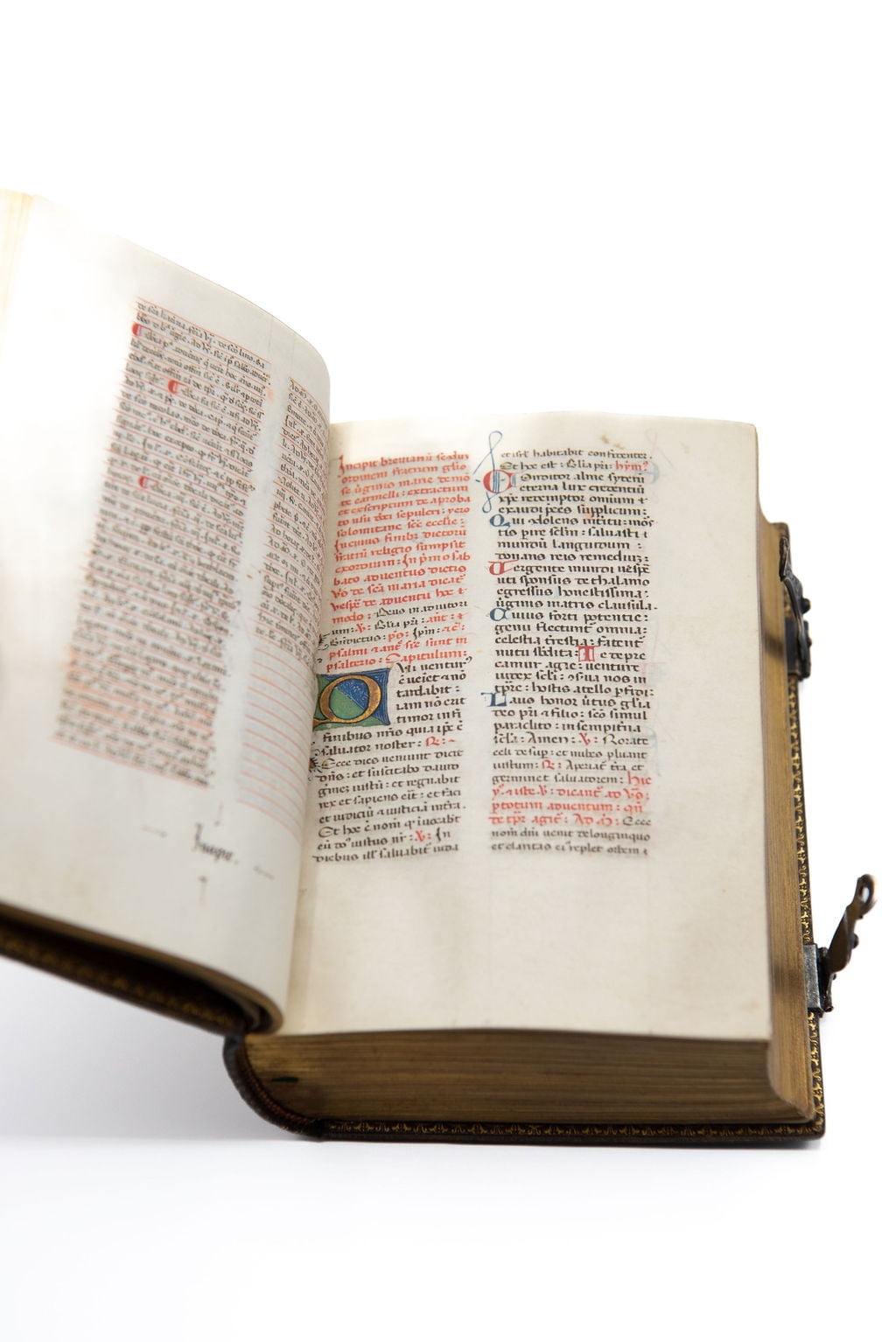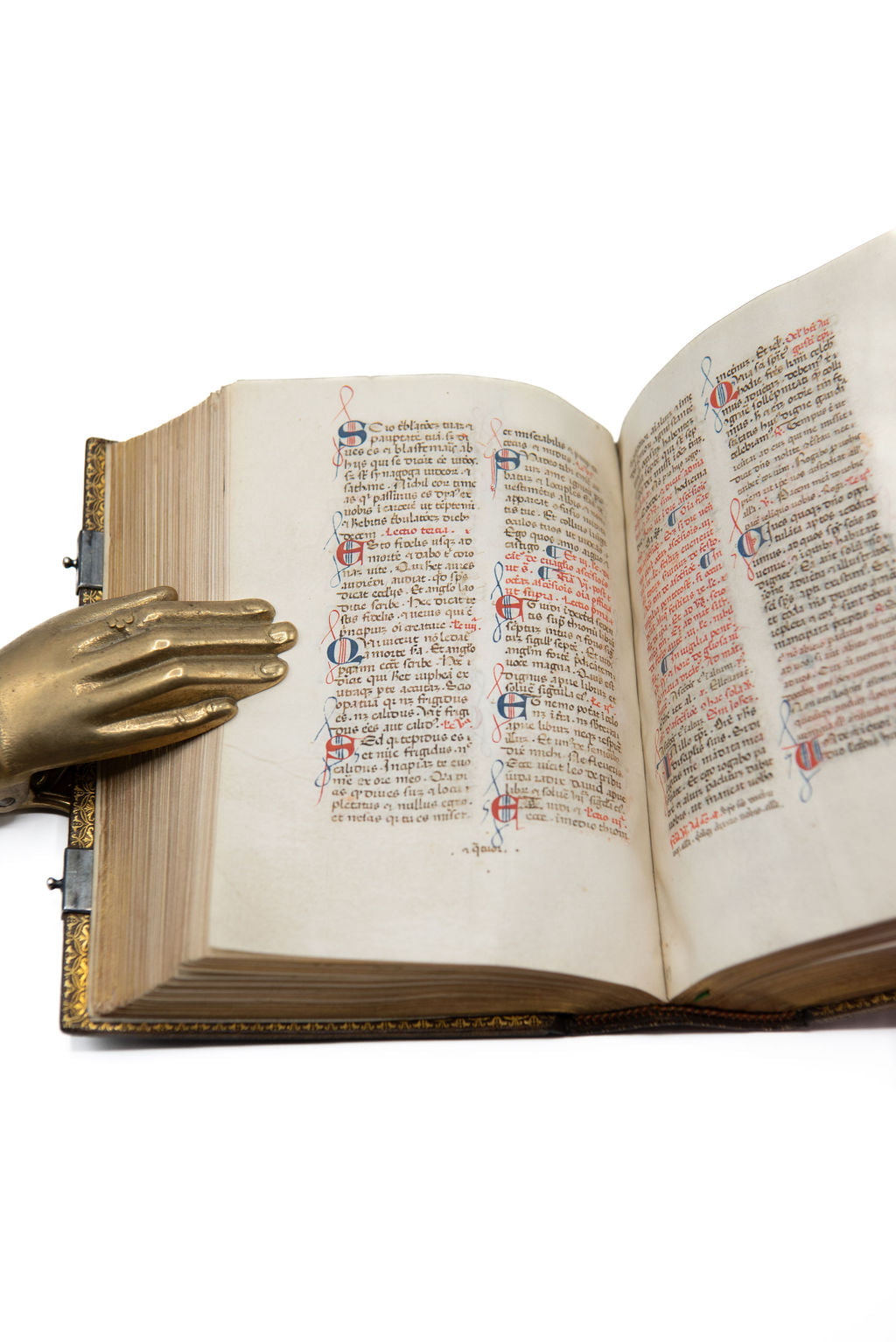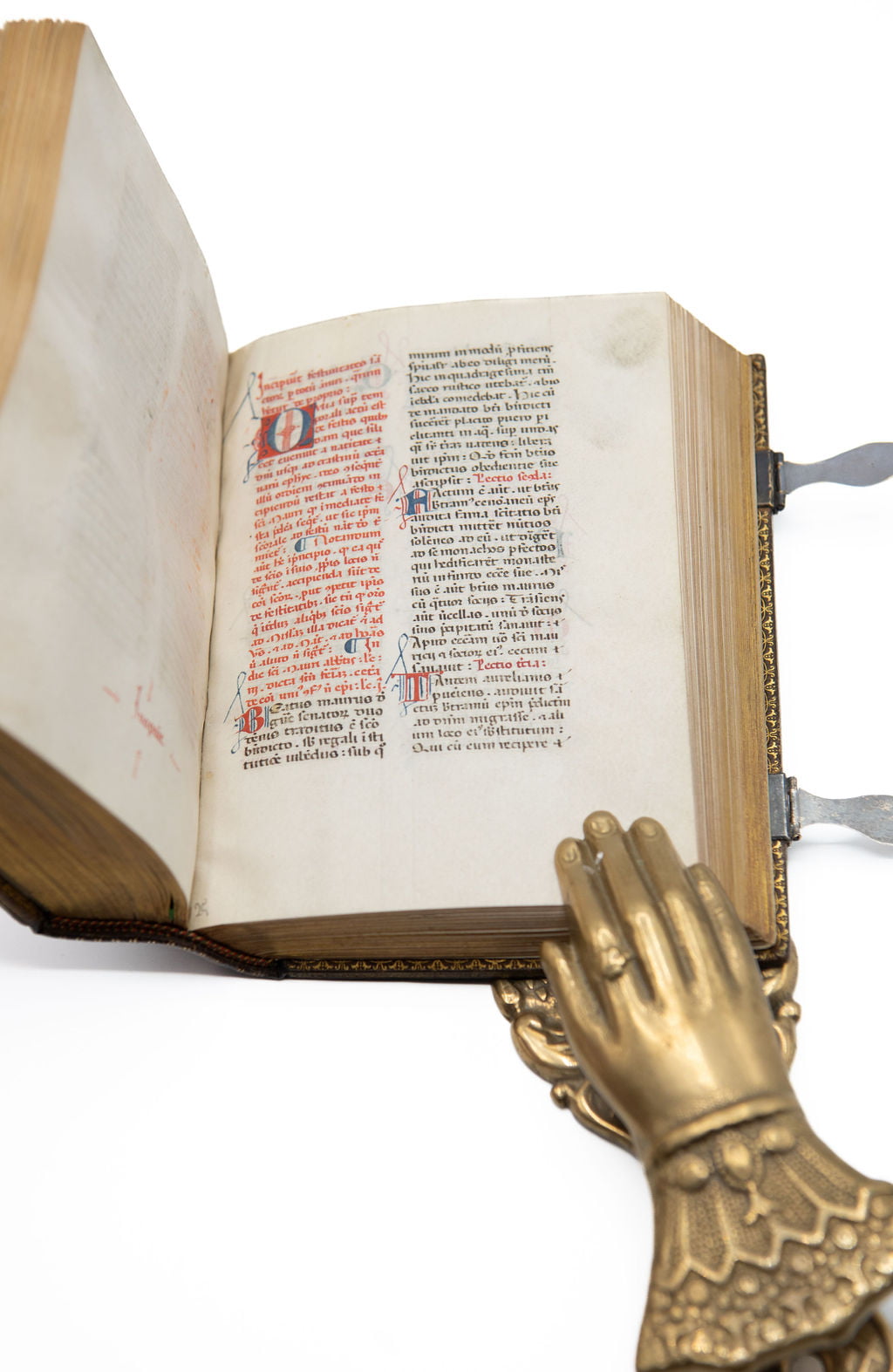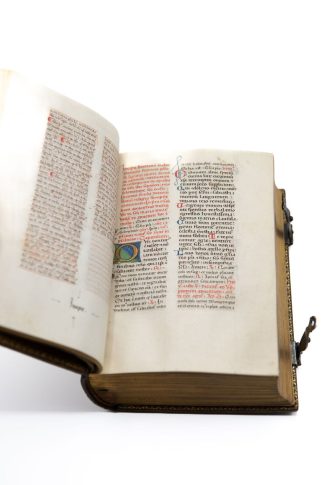CARMELITE BREVIARY.
Illuminated manuscript in Latin on vellum.
[Italy and perhaps also southern France, mid-fifteenth century]£27,500.00
8vo, 150 by 105mm, 398 leaves, wanting two single text leaves, else complete, collation: i7 (wanting the first leaf, once the flyleaf and thus a cancelled blank), ii4, iii-v8, vi-xxvi10, xxvii8, xxviii-xxxvii10, xxxviii5, xxxix10, xl7, xli7, last apparently a cancelled blank. Catchwords, text in double column of 33 lines of rounded Italian bookhand, capitals touched in pale yellow wash, rubrics in red, one-line initials in red or blue, 2-line initials in same with contrasting penwork, larger initials in same on square ground in contrasting colour or gold on bicoloured grounds heightened with white foliate penwork and with French-looking spiky seed pods in sprays of foliage emerging from corners into the margin. A few small spots and stains, some fading and old water damage to Calendar, else in excellent condition; mid nineteenth-century brown morocco tooled in gilt by E. Neidrée, boards with floral gilt frames and sprays of foliage at corners, spine in gilt-tooled compartments, erroneous title “Horae / B. Virginis / XIIme Siecle”, with marbled doublures and gilt edges, brass clasps, in a custom leather box.
Provenance:
- Written and decorated for use by a Carmelite friar in the fifteenth century, main text opening “Incipit breviarium secundum ordinem fratrum gloriose virginis marie de monte carmelli” and entries in the Calendar specific to that Order. In March for the saint-doctors “ordinis Camelitarum”; St. Albert of Jerusalem on 7 August as “ordis car” (introduced in 1411); St. Martial of Limoges on 7 July, whose feast was introduced by the Carmelites; St. Blaise on his distinctively Carmelite feast on 23 January, “montis carmelli”; St. Cyril of Constantinople an early prior of the Order, “ordinis camelitarum” on 6 March; among others. Due to the movement of Carmelite friars over large distances, their books often reflect influences from a number of places; here the script and most of the decoration is Italian, while a single initial, bicoloured grounds with very French looking spiky seed pods, points towards France. The Calendar reflects the geographical distribution of the Order (see below) with predominantly Italian, southern and central French saints, and very occasional Englishmen such as St. Richard of Chichester. The book was most probably carried by its original owner from Italy to southern France, and then survived the following centuries in a French convent until the secularisation of religious houses around 1800, and the spilling of the libraries of religious institutions onto the open market.
- Most probably owned by Amans Alexis Monteil (1769-1850), French historian; the records of the BnF. connect his library to that of Janin (the next owner of this book, who also posthumously re-edited Monteil’s magnum opus) suggesting that the “Rituel a l’usage des Carmes petit in 8v MS. du 15 siècle sur vélin” in the sale catalogue of Monteil’s library in Paris on 11 June 1850, lot 14, is the present volume.
- Jules Gabriel Janin (1804-1874), journalist, critic, author and book collector: his gilt tooled leather bookplate (pencil notes on flyleaf say this is no. 19 in his catalogue, and it is indeed in the Catalogue des livres rares et précieux composant la bibliothèque de M. Jules, 1877, as that number, misdescribed as a “Horae Beatae Virginis” of the “XIIIe siècle”, following the title on the spine and nineteenth-century pencil notes on the flyleaves). Most probably rebound for him by E. Neidrée (recorded in the Janin catalogue).
- T.B. Neely (1841-1925), bishop of of Philadelphia, PA: his ex libris on flyleaf. Presumably passing by descent, and still in Philadelphia in 1962 when examined by Dr. James J. John of the Institute for Advanced Studies of Princeton for the Free Library of Philadelphia (correspondence enclosed in book).
- Re-emerging recently in the US. Purchased by a US individual from a local auction house in Philadelphia, around 1990s.
- Purchased at Swann galleries auction in May 2022, Sale 2603, Lot 198.
Text:
The Carmelites were a religious Order most probably founded on Mount Carmel in Palestine during the short period in which Europeans founded and held the Crusader States in the Holy Land, they initially inhabited caves once used by Old Testament and Early Christian hermits. The Carmelites came to Europe only in the 1230s, and were not a notable presence before the fall of the Holy Land to the Mameluks. They changed their way of life from eremitic to mendicant, and committed their energies to preaching missions similar to those of the Franciscans and Dominicans.
Having spent their formative years in the Holy Land, the Order never had the widespread European success of the Franciscans and Dominicans, their houses predominantly in southern France, Italy, Sicily and Cyprus, with outliers in England. Thus, Carmelite books are of significant rarity, the last on the market was a Breviary from the Carmelites of Semur-en-Auxois sold by Sotheby’s, 6 December 2016, lot 29, and then dispersed in the trade the leaves with the ex libris marks ending up in the Roger Martin collection; a devotional compendium sold in the same rooms, 5 July 2011, lot 96, as part of the Bergendal collection; and a Book of Hours and Prayerbook sold in Sotheby’s, 5 December 2006, lot 46, to the American arm of the present Carmelite Order. Of those, only the book once in the Bergendal collection predated the fifteenth century, and that by only a decade or so. Christie’s has had none since a fifteenth-century Breviary sold on 2 December 1987, lot 170, as part of the Doheny collection, and Bloomsbury Auctions sold only a single Prayerbook of the sixteenth century on 9 December 2015, lot 120.
The focus of these books on the breviary is interesting. The vow of poverty and travel entailed in a mendicant lifestyle prohibited the ownership of large libraries by individuals, and a breviary was frequently the only book owned by a Carmelite friar as his sole practical tool in celebrating the ecclesiastical year. These books were commonly bought with an allowance from the Order at the end of the novitiate, and could not be sold or given away, but were recoverable after his death by the convent where he first said Mass and given to another to use in turn. As such, Carmelite breviaries are the very core books of the life of the friars, central to their experience of a religious life.
The text here comprises: a Calendar; records of various feasts arranged by the ecclesiastical year (here “Memorie per totum annum”), followed by benedictions and prayers; the Sanctoral; and the Temporal.
In stock






